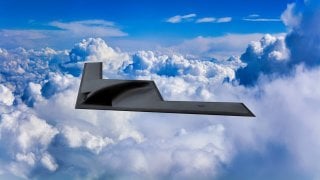B-21 Raider: The Air Force Wants a Fleet of 100 Stealth Bombers
The B-21 Raider, developed by Northrop Grumman, is set to replace the aging B-1B Lancer and B-2 Spirit bombers. Building on the B-2's flying wing design and stealth capabilities, the B-21 promises to enhance radar evasion with advanced technology, some of which remains classified.
Summary and Key Points: The B-21 Raider, developed by Northrop Grumman, is set to replace the aging B-1B Lancer and B-2 Spirit bombers. Building on the B-2's flying wing design and stealth capabilities, the B-21 promises to enhance radar evasion with advanced technology, some of which remains classified.
-Designed for the 21st century, it incorporates lessons from the F-117, B-2, F-22, and F-35. Cost-effectiveness is a priority, with an open systems architecture allowing for rapid updates.
-The U.S. Air Force plans to deploy at least 100 Raiders, aiming for both technological superiority and operational strength by the 2030s.
-Aerospace and defense giant Northrop Grumman continues to develop its B-21 Raider long-range strategic bomber. The B-21 is the planned replacement for the aging B-1B Lancer and B-2 Spirit bombers.
B-21 Raider: The U.S. Air Force’s Next-Generation Stealth Bomber
Information is still sparse on the Raider, which is named for the men who took part in the Doolittle Raid on Tokyo in the spring of 1942. But there are several facts about the B-21 that we do know.
The B-21 is Building on the B-2's Success
The stealthy B-21 will not be the first Air Force bomber to feature a flying wing design to reduce its radar signature. Efforts to build an aircraft without a fuselage date back almost 100 years. Northrop Grumman’s B-2 Spirit was the first such design mass-produced, even if just 20 aircraft were manufactured.
Seen as the first successful flying wing aircraft, the B-2’s low-observable characteristics help it penetrate an enemy's most sophisticated defenses and threaten its most heavily defended targets. With these capabilities, the B-2 has ensured a strong, effective deterrent and combat force well into the 21st century.
The B-2's low observability was derived from a combination of reduced infrared, acoustic, electromagnetic, visual, and radar signatures. These signatures make it difficult for sophisticated defensive systems to detect, track, and engage the B-2. Many aspects of the low-observability process remain classified, but the B-2's composite materials, special coatings, and flying wing design all contribute to its stealthiness.
The Raider Bomber is Better
Everything the B-2 Spirit did right, the B-21 Raider promises to do better. There were reports its advanced stealth technology – much of which remains classified – could give the aircraft a radar signature as small as an insect. That's likely hyperbole, as no one expects to track a butterfly on radar.
The B-2's development began when disco was all the rage and Jimmy Carter was in the White House, while the B-21 Raider's development is truly a product of the 21st century. It takes into account numerous lessons learned from the F-117 Nighthawk, B-2 Spirit, F-22 Raptor, and F-35 Lightning II – and likely from programs yet to be disclosed.
As The Heritage Foundation reported, the B-21 Raider "is built around the most sophisticated and easily maintained stealth technology ever developed."
Even the aircraft's maker was only slightly more forthcoming, describing the B-21 as benefiting "from more than three decades of strike and stealth technology. It is the next evolution of the Air Force strategic bomber fleet. Developed with the next generation of stealth technology, advanced networking capabilities and an open systems architecture, the B-21 is optimized for the high-end threat environment. It will play a critical role in helping the Air Force meet its most complex missions."
Some 8,000 employees of Northrop Grumman and various other defense contractors of all sizes, spread across 40 states, have been secretly building the Air Force's new stealth bomber. Great efforts have been taken to prevent China and other potential adversaries from gaining access to its technology.
Cost-Effective as Well as Stealthy
Even the best aircraft is only good if it can be employed in significant numbers. The simple lack of B-2s has been the Spirit’s greatest weakness. The Air Force is seeking to guarantee the production of at least 100 Raiders.

To that end, the air service has emphasized cost containment while simultaneously allowing for maximum flexibility. The future backbone of the Air Force's bomber fleet has been noted for an open systems architecture that would allow future capabilities to be integrated into the aircraft, and fast.
With the B-21, the Air Force plans not only to have the best stealth bomber in service for years to come. By the end of the 2030s, it also plans to operate a strong number of these aircraft.
Author Experience and Expertise: Peter Suciu
Peter Suciu is a Michigan-based writer. He has contributed to more than four dozen magazines, newspapers, and websites with over 3,200 published pieces over a twenty-year career in journalism. He regularly writes about military hardware, firearms history, cybersecurity, politics, and international affairs. Peter is also a Contributing Writer for Forbes and Clearance Jobs. You can follow him on Twitter: @PeterSuciu. You can email the author: [email protected].
Image Credit: Creative Commons.


